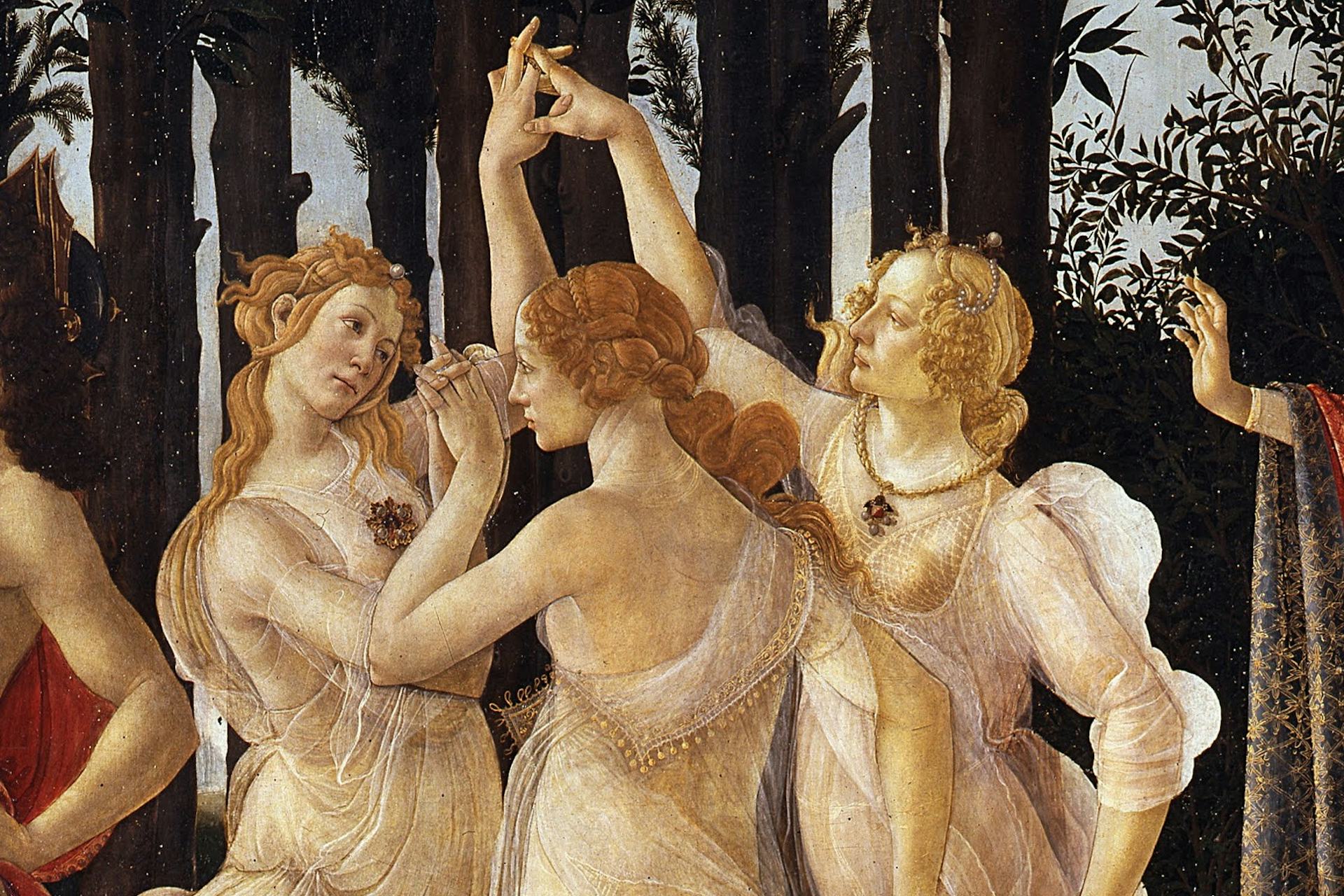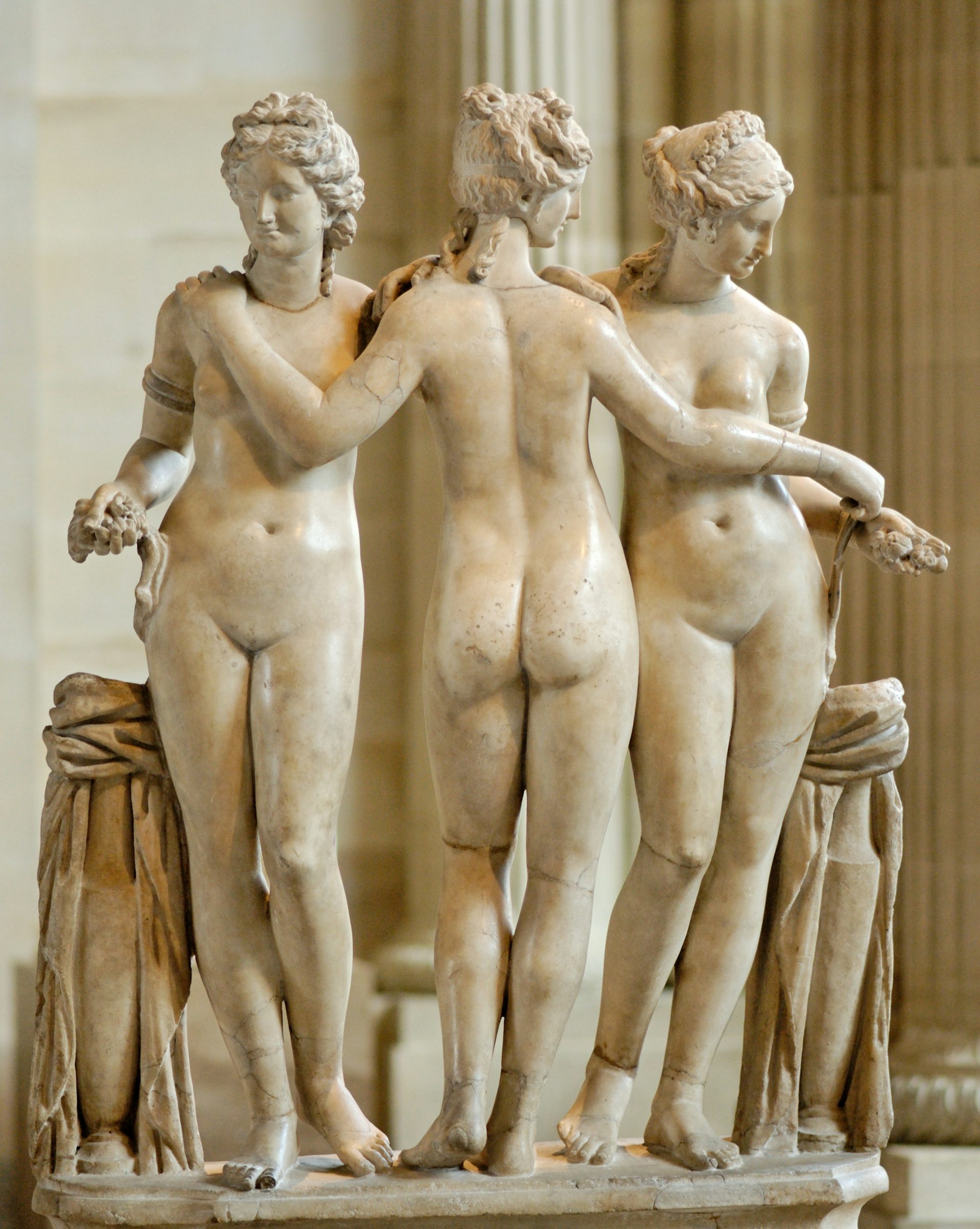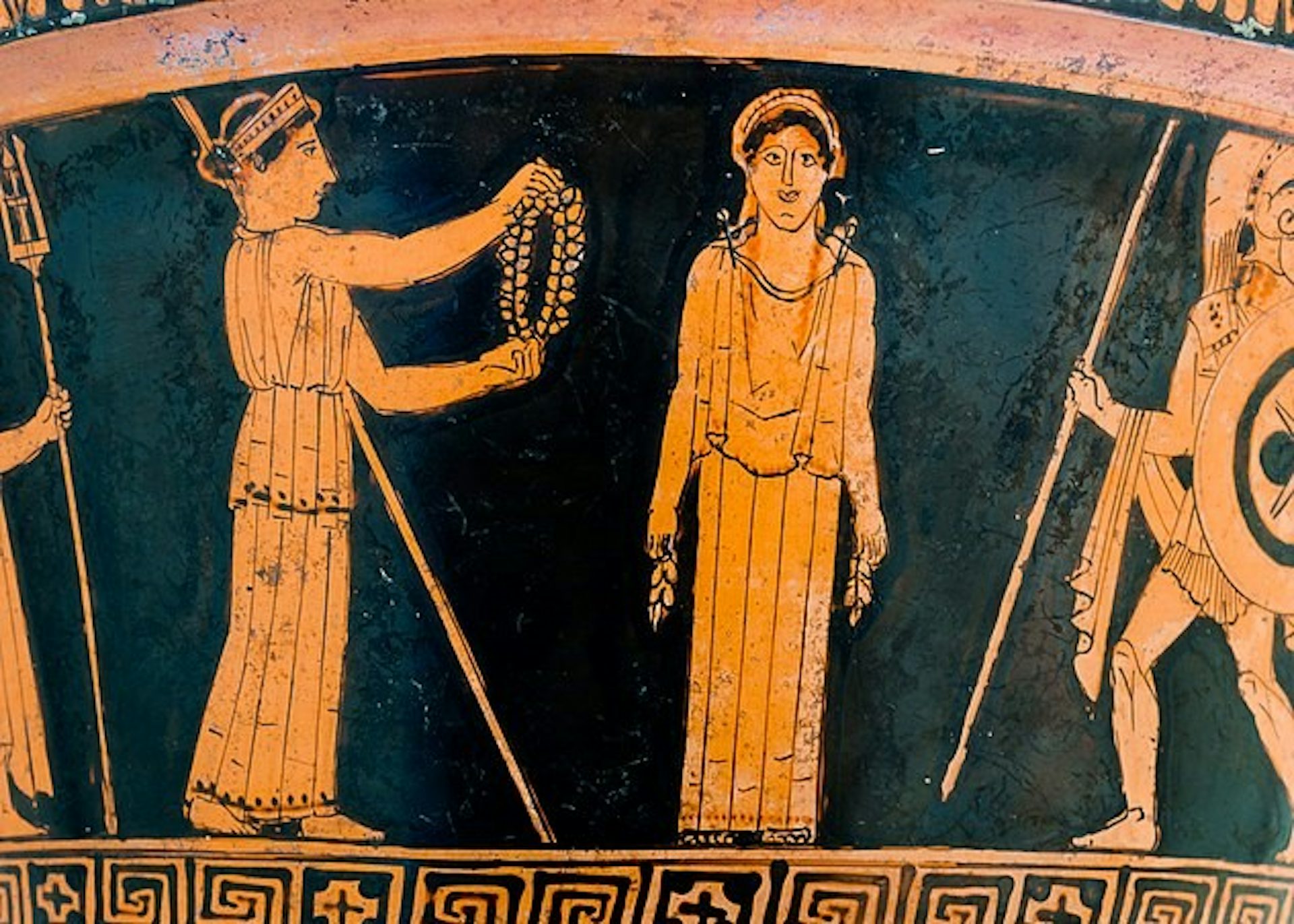Charites (Graces)

Detail from Primavera by Sandro Botticelli (1485–1487), showing the three Graces (Charites)
Uffizi Gallery, FlorencePublic DomainOverview
The three Charites or “Graces” were beautiful, kind, and youthful goddesses who embodied all things involving beauty, joy, and abundance. In the standard account, known from Hesiod’s Theogony, there were three Charites named Aglaea (“Radiance”), Euphrosyne (“Joy”), and Thalia (“Abundance”), daughters of Zeus and the Oceanid Eurynome. But there were other traditions too surrounding the names, number, and parentage of the Charites.
The Charites were primarily invoked as the goddesses responsible for bestowing beauty, grace, and happiness in all kinds of contexts, especially social gatherings and celebrations. They were close attendants of Aphrodite, and often appeared together with her in literature and art. Kind and youthful goddesses, the Charites were always represented as beautiful young women; in art, they were characteristically depicted in the nude. The Charites played a limited role in ancient mythology, but their worship was quite widespread, especially in Boeotia.
Etymology
The term “Charites” (Greek Χάριτες, translit. Chárites; sing. “Charis,” Greek Χάρις, translit. Cháris) is identical with the Greek word meaning “charm, favor, gratitude.” The word itself comes from the Indo-European *ǵʰer(H)-, meaning “desire, enjoy.”[1]
The Romans knew the Charites as the “Gratiae,” the Latin translation of the Greek Charites. This is the origin of the English term “Graces,” often used today to refer to the Charites.
Pronunciation
English
Greek
Charis, Charites Χάρις (Cháris), Χάριτες (Chárites) Phonetic
IPA
[KEY-ris, KAR-i-teez] /ˈkeɪ rɪs, ˈkær ɪˌtiz/
Titles and Epithets
The epithets of the Charites were the typical epithets used to describe many Greek goddesses—epithets such as ἁγναί (hagnaí, “august”), βασίλειαι (basíleiai, “queens), προσηνεῖς (prosēneîs, “tender”), and σεμναί (semnaí, “holy”).
The names of the individual Charites, moreover, were virtually epithets in their own right, reflecting the functions of the goddesses (see below). Individual Charites could carry additional epithets too: Hesiod, for example, refers to the Charis Thalia as ἐρατεινή (erateinḗ), “lovely.”[2]
Attributes
Names and Number
According to Hesiod’s Theogony, there were three Charites and their names were Aglaea (“Radiance”), Euphrosyne (“Joy”), and Thalia (“Abundance”).[3] This would become the standard tradition for the name and number of the Charites, but it was far from the only tradition. Homer, usually thought to have written a little earlier than Hesiod, did not specify how many Charites there were, and he named two Charites who would not appear in Hesiod: Pasithea[4] and Charis.[5]
There were different collections of “Charites” worshiped locally throughout the Greek world. In Sparta, the Charites were called Clete (“Renowned”) and Phaenna (“Bright”).[6] In Athens, the Charites were Auxo (“Grower”) and Hegemone (“Leader”);[7] a third Athenian Charis, Thallo (“Blooming”), may have sometimes been added too.[8] The goddesses Auxesia and Damia, who were worshiped in various parts of Greece including Aegina, Sparta, and Troezen, seem to have been similar in function to the Charites and may have even been regarded as local Charites themselves.[9]
Other sources apparently knew of further Charites. One tradition added Peitho (“Persuader”) to the ranks of the Charites.[10] Another added Cale (“Beautiful”).[11] The late poet Nonnus, combining several sources, named the Charites as Pasithea, Aglaea, and Peitho.[12] There may have been other traditions about the number and names of the Charites too.[13]
Functions and Characteristics
The Charites, often known as the Graces, embodied all things connected with beauty, joy, and abundance. They were mostly responsible for bestowing beauty, charm, and grace in all areas of life, especially in social gatherings, celebrations, and the arts. The names of the individual Charites—given by Hesiod as Aglaea (“Radiance”), Euphrosyne (“Joy”), and Thalia (“Abundance”)—represent abstract qualities and suggest that the goddesses may have originated as chthonic deities associated with the earth, nature, and fertility.
The Charites were similar in many ways to other groups of female deities, such as the Muses and the Horae. Like the Muses and the Horae, the Charites enjoyed dancing, singing, and poetry.[14] Their attributes were flowers such as roses and myrtles, and it was they who made roses grow.[15] According to Hesiod, they dwelled atop Mount Olympus with Himerus, “Desire” personified, not far from the home of the Muses.[16] The Charites were also closely associated with Aphrodite. Indeed, they were often represented as the attendants of the goddess of love.

Roman Imperial statue of the three Graces (ca. 2nd century CE), restored by Nicolas Cordier in 1609
Borghese Gallery, Louvre Museum, Paris. Marie-Lan NguyenPublic DomainThe Charites had a fairly well developed personality. They were portrayed as beautiful, gentle, and benevolent goddesses, “from whose eyes as they glanced flowed love that unnerves the limbs.”[17] They seem to have been viewed as friendlier to humans than other similar goddesses, such as the Muses, who tended to treat even their most fervent human devotees with contempt.[18]
Iconography
The Charites were popular in ancient art from an early period, showing up in sculpture, vase paintings, and coins. They were always depicted as young, attractive maidens, similar to many goddesses and thus difficult to identify at times.
Around the Hellenistic Period (323–31 BCE), however, the Charites acquired a distinctive iconography: they were characteristically shown nude, standing together with their hands on each other’s shoulders. In some representations they seem to be dancing.
The Charites often carried various attributes, including flowers, garlands, grains, or fruits. Sometimes they were shown near closed jars, which may have symbolized their virginity. Various local manifestations of the Charites boasted attributes that were less universal or else shared with deities such as the Horae or nymphs: in the city of Elis in the western Peloponnese, for example, the Charites were represented holding knucklebones and myrtle.[19] The Charites were sometimes accompanied by other gods, such as Aphrodite or the nymphs.[20]
Family
The standard tradition, outlined in Hesiod’s Theogony, made the Charites daughters of Zeus, the ruler of the gods, and the Oceanid Eurynome.[21] But there were many alternative traditions regarding the parentage of the Charites. Other sources agreed with Hesiod that the father of the Charites was Zeus, but they named their mother as Eunomia,[22] Hermione,[23] Hera,[24] or either Aegle, Euanthe, Eurydome, or Eurymedusa.[25] Others made the Charites daughters of Uranus,[26] of Dionysus and Aphrodite,[27] of Dionysus and Coronis,[28] of Helios and the Naiad Aegle,[29] of Lethe,[30] and perhaps even of Erebus and Nyx.[31]
A few of the Charites were said to have married and even to have borne children. According to Hesiod, the Charis Aglaea was the wife of Hephaestus, god of the forge;[32] Homer also made one of the Charites the wife of Hephaestus, but he gave her name simply as Charis.[33] Another Charis, Pasithea, is in Homer promised as the wife of Hypnos, the god of sleep.[34] The Spartans regarded the Charis Cleta as the wife of Eurotas and the mother of the nymph Sparta.[35]
Mythology
The Charites did not play an important role in ancient mythology. Yet the Charites were highly recognizable goddesses, daughters of Zeus himself, and they made their home on Olympus beside the most important gods of the Greek pantheon. In one tradition, their nurse was Hera, the queen of the gods.[36]
The Charites often appeared as the associates or attendants of more important gods, especially Aphrodite. In the Iliad, for instance, Aphrodite is wearing a robe woven by the Charites when she is wounded in battle by the Argive hero Diomedes,[37] while in the Odyssey it is the Charites who bathe and dress Aphrodite after she was ensnared in the net of Hephaestus and shamed in front of all the gods.[38] In a happier scene, the Charites attended on Aphrodite when she decked herself out to seduce the handsome Trojan herdsman Anchises.[39]
The Charites make an appearance in Hesiod’s retelling of the myth of Pandora. When the gods fashioned Pandora to bring ruin upon human beings, they took care to endow her with all the gifts they had at their disposal: Hephaestus, the smith god, shaped the beautiful woman from clay, ang the gods breathed craft and intelligence into her and dressed her lavishly, as “the divine Graces [Charites] and queenly Persuasion put necklaces of gold upon her, and the rich-haired Hours crowned her head with spring flowers.”[40]

Red-figure calyx-krater showing the creation of Pandora, attributed to the Niobid Painter (ca. 460–450 BCE)
British Museum, London / ArchaiOptixCC BY-SA 4.0In another myth, Hera used the Charis called Pasithea as a bargaining chip: she promised Helios, the god of sleep, to give him the beautiful Pasithea as a bride if he caused her husband Zeus to fall asleep (Hera wanted Zeus distracted so that she could send military aid to the Greeks in their battle against the Trojans, which Zeus had expressly forbidden). Hypnos was readily persuaded to do Hera’s bidding in exchange for so desirable a prize.[41]
The Charites occasionally featured in other myths too. In the Cypria, an early epic that is known today only from fragments, the Charites attended Aphrodite at the wedding of Peleus and Thetis and even performed in the festivities.[42] There was also one obscure tradition that told of a beauty contest between Aphrodite and the Charis Cale. The wise prophet Tiresias was summoned to judge the contest, and he judged in Cale’s favor. This of course enraged Aphrodite, who retaliated by transforming Tiresias into an ugly old weaver woman.[43]
Worship
The cult of the Charites was especially important in ancient Boeotia, though it was widespread in other parts of the Greek world too, including Attica, the Peloponnese, and Anatolia.
Probably the most important cult of the Charites was centered in the Boeotian city of Orchomenus.[44] The worship of the Charites here was very old, possibly going back to a triad of local goddesses known from prehistoric times. By the second century BCE, and likely long before then, the Charites of Orchomenus were worshiped in the form of meteorites.[45] A festival called the Charitesia was celebrated locally in honor of the three goddesses from at least as early as the first century BCE. This festival mainly involved musical and dramatic events, but also included athletic contests.[46]
Other forms of the Charites were worshiped in other places. The Spartans and Athenians both honored two Charites instead of three: Clete and Phaenna in Sparta (by the Tiasa River),[47] Auxo and Hegemone in Athens.[48] In Athens, there was an early shrine and cult of Demos (the People) and the Charites on the northwest corner of the agora; by the early second century BCE, Aphrodite was worshiped with them too.[49]
At Olympia, the Charites received cult honors as Olympian gods, and they shared an altar with Dionysus, the god of wine.[50] The goddesses also had other sanctuaries, temples, and sacred images at various other sites, including Hermione,[51] Sparta,[52] Paros on Cyprus,[53] Coronea (in the Temple of Athena Itonia),[54] and Delos (in the Temple of Apollo).[55] At Ace, a stop on the road from Megalopolis to Messene, sacrificial offerings were made to the Charites together with the Eumenides.[56]